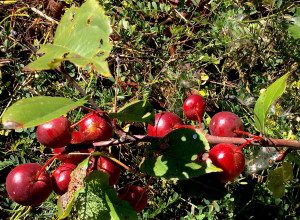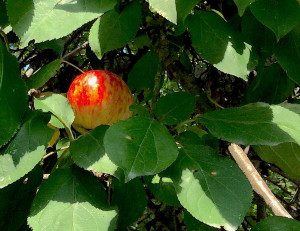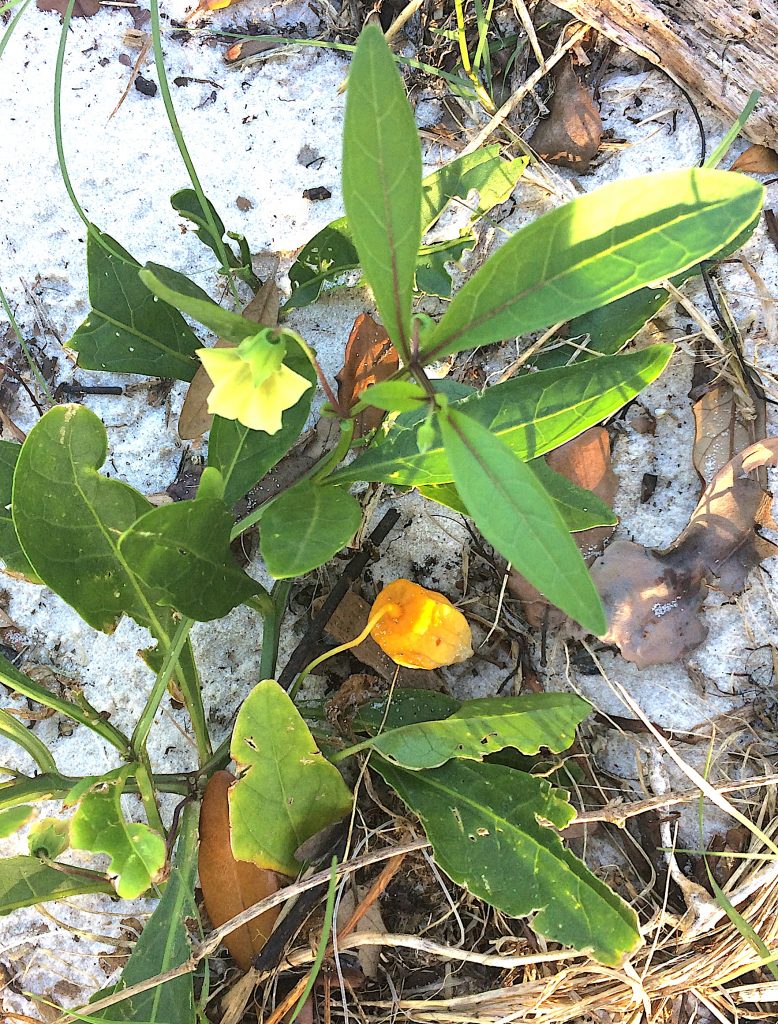
As the Ground Cherry ripens the husk turns golden. Photo by Green Deane
It was fruit day last Sunday during our class in Port Charlotte. The mangoes were done but the Java Plum(Jambul) was just starting and Star Fruit littered the ground. A great tasty surprise was many golden ground cherries.There are several species locally and those were Physalis viscosa aka Physalis angustifolia. I pocketed some seeds for planting. Compared to exactly a year ago the coco-plums. were late. we only found a couple. A year ago there were so many I picked ten pounds and started two experimental gallons of wine. Fruiting some was the Natal Plum which is not really a plum but a close relative to the toxic Oleander. All parts of the Natal Plum are toxic except the ripe fruit. Podocarpus arils were ripening, right on time.
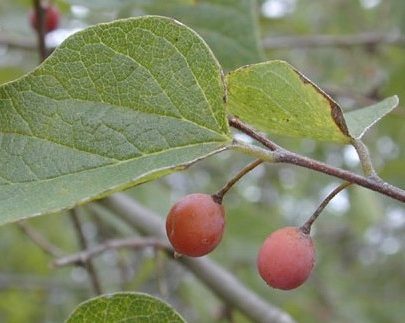
Hackberries, or sugarberries, are usually burnt orange in color.
People ofter launch into arguments over the common names of plants. That should not come as a surprise: Botanists get into arguments over the official names of plants. So is the tree a “Sugarberry” or a “Hackberry?” Some will argue the distinction is geographic, other will assert the names apply to different species. I call it a big tree with little burnt-orange fruit that is edible around Setember. In real estate it is “location, location, location.” Hackberries-Sugarberries like to be near fresh water such as lakes, ponds, streams or a very reliable irrigation-sprinkler system. They don’t like being waterlogged. But you won’t find them on the top of a dry hill either. Usually you can find them up the bank from water. Older trees usually have warty bark, no thorns. Leaves have uneven shoulders, one down or one up, and on the back side of the leaf notice three prominent veins at the base. Often the leaves have many insect galls and or a black smut on them (the latter does not affect the tree or us. It is also found on useable persimmon leaves.) The pea-sized fruit is burnt to medium orange in color sometimes red depending on the species. The entire fruit is edible though the seed is hard. So you can eat the pulp, and or crunch the seed, or mash entire fruits into cakes. To read more about the Hackberry or Sugarberry go here.
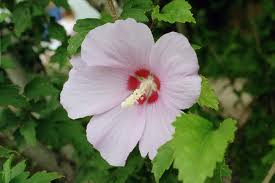
The large blossom of the swamp mallow.
Hibiscus moscheutos is one of my mystery plants and ranges over much of the United States except for the high plains states and the west coast (and my native state of Maine.) The Swamp Rose Mallow is blossoming in damp spots locally particularly along the St. John River. I think its blossoming is more related to the shortening of the days than the weather per se. It has five separate petals united at the base and five green sepals. The blossom lasts only one day. They range from cream with a red or purple center to pale pink. It has a sticky, stringy juice. The question is, as a Hibiscus, are the blossoms edible or other parts? I have never found a reference to edibility. In fact, it seems only one Native American tribe used it medicinally, the Shinnecock who lived on what we now call Long Island. They used it for bladder infections. European settlers, however used the species for a wide variety of ailments. As several writers attest it “abounds with mucilage.” It is always interesting when such a wide-spread plant is rarely mentioned in the ethnobotanical literature. That could mean it wasn’t used, we didn’t ask, or they didn’t tell us. To read more about mallows go here.
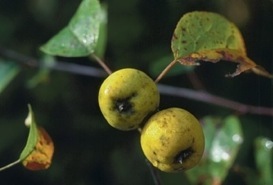
Bitter wild apples can be roasted. Photo by Green Dean.
September approaches and that means wild apples. I’ve never met a bad wild apple. There are sweet ones — edible off the tree — and there are bitter ones, often very good after roasting like a root vegetable. Nearly all apples are edible and are clones, well, at least commercial apples are clones. The experts tell us no two apple seeds are exactly alike. Granny Smith apple seeds will not product a Granny Smith apple. The first Granny Smith apple tree was a unique tree and was cloned, as were all the other named apples we buy in the store or grow at home. Cloning might not be exactly the right term: Cuttings were taken from that tree and grafted on to other apple trees. That’s why it took nearly a century for the Granny Smith apple to get from Australia to our markets in the United States.
What I noticed as a boy was the great variety of apple trees there were around the fields, old homesteads, and roads where I grew up. Near the house, where our horses could raid it, was an old small wild apple that had green fruit tasting tart to bitter. We made pipes out of the wood. But, the apples cooked well and the horses liked them as is, right off the tree with a few leaves. Just outside their fence there was a large (I suspect cultivated) tree with apples that tasted similar to a Golden Delicious. Across the dirt road from the house were five apple trees on the shoulder, offsprings of a tossed apple core and subsequent generations.
I thought of these while hiking the Appalachian Trail. Feral apple trees were common and good. I harvested apples every time I saw a tree. Not one tree looked as if anyone had bothered to collect any apples from them (low-hanging fruit was still low-hanging.) This latter observation is perhaps the most telling. Humans have been eating apples for some seven thousand years. They are one of the best known foods even among people who never forage. It is difficult to think of a food more recognizable than apples yet they remained unharvested along the trail and elsewhere. Even ardent must-get-back-to-nature types leave them alone. Maybe we are not as hungry as we think we are. I also see mangoes rotting on the ground often. To read more about apples, go here.
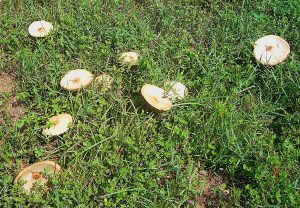
Green-spored False Parasols are NOT edible
What is that mushroom on your lawn? Locally a toxic mushroom has been responding to the rain, the Green Spore Parasol also called the False Parasol, Chlorophyllum molybdites. It causes more non-fatal mushroom poisonings than any other species in North America. This is because it has some close look alikes that are edible. The Green Spore Parasol is close to unique in that it is among the few mushrooms with green spores. If you pull off the stem and lay the cap on a white piece of paper or clear plastic for a few hours to a day it will leave a green spore print. A large mushroom, they almost aways pop up on lawns and often in a “troop” or what we used to call a fairy ring. Also called the “Gut Wrencher” and the “Vomiter” a few people seem immune to its toxin but don’t try it. The one death on record involved a two-year old child who ate some raw, had convulsions, then died 17 hours later. Adults usually get go-to-the-hospital bloody diarrhea, among other gastro-intestional symptoms. There is, however, no lasting organ damage. The mushroom is deadly to horses.
Saturday, August 20th, Mead Garden: 1500 S. Denning Dr., Winter Park, FL 32789. Meet at the bathrooms. 9 a.m.
Sunday, August 21st, Florida State College, south campus, 11901 Beach Blvd., Jacksonville, 32246. We meet at Building A next to the administration parking lot. 9 a.m.
For more information, the pre-pay for a class, or sign up go here.

You get the USB, not the key.
Changing foraging videos: As my WordPress pages are being updated the video set will go away. They are the same videos I have on You Tube. Some people like to have a separate copy. The DVD format, however, is becoming outdated. Those 135 videos plus 36 more are now available on a USB drive. While the videos were played from the DVDs the videos on the USB have to be copied to your computer to play. They are MP4 files. The 171-video USB is $99. If you make a $99 “donation” using the link at the bottom of this page or here, that order form provides me with your address, the amount — $99 — tells me it is not a donation and is for the USB.

Green Deane Forum
Want to identify a plant? Perhaps you’re looking for a foraging reference? You might have a UFO, an Unidentified Flowering Object, you want identified. On the Green Deane Forum we — including Green Deane and others from around the world — chat about foraging all year. And it’s not just about warm-weather plants or just North American flora. Many nations share common weeds so there’s a lot to talk. There’s also more than weeds. The reference section has information for foraging around the world. There are also articles on food preservation, and forgotten skills from making bows to fermenting food.
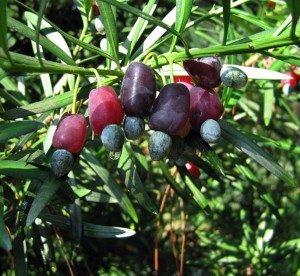 As mentioned a couple above Podocarpus will be coming into full season soon. In my foraging classes we are finding a few ripe arils here and there. They are tasty and quite grape-like. Locally hedge-Podocarpus tend to be in season in August. Occasionally there is a Podocarpus tree that ripens in December (a different species I presume.) The shrub is in season for a month or more. Look for them in landscaping around homes, churches, and college campuses. They are also edible when they look like raisins (don’t forget to throw away the seed on the end. We don’t eat that.) To read more about them go here, for a video, here.
As mentioned a couple above Podocarpus will be coming into full season soon. In my foraging classes we are finding a few ripe arils here and there. They are tasty and quite grape-like. Locally hedge-Podocarpus tend to be in season in August. Occasionally there is a Podocarpus tree that ripens in December (a different species I presume.) The shrub is in season for a month or more. Look for them in landscaping around homes, churches, and college campuses. They are also edible when they look like raisins (don’t forget to throw away the seed on the end. We don’t eat that.) To read more about them go here, for a video, here.
This is weekly newsletter #520. If you want to subscribe to this free newsletter you can find the sign-up form in the menu at the top of the page.
To donate to the Green Deane Newsletter click here.

